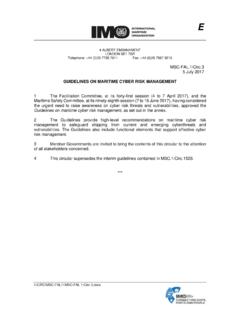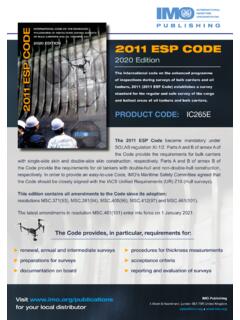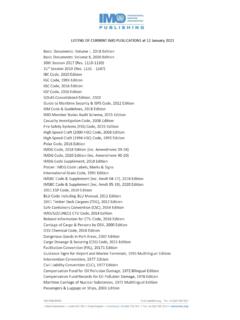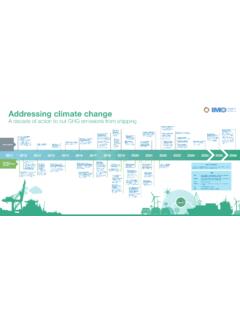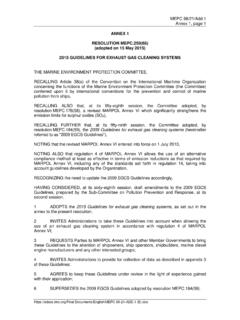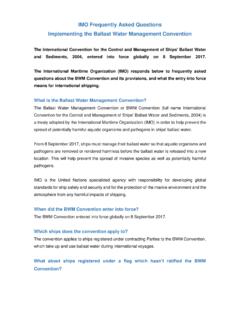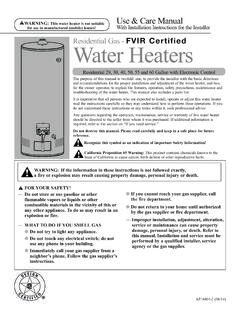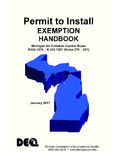Transcription of RESOLUTION MEPC.308(73) (adopted on 26 October 2018) …
1 RESOLUTION (73) (adopted on 26 October 2018) 2018 GUIDELINES ON THE METHOD OF CALCULATION OF THE ATTAINED ENERGY EFFICIENCY DESIGN INDEX (EEDI) FOR NEW SHIPSMEPC 73/19 Annex 5, page 1 I:\ MEPC\73\MEPC ANNEX 5 RESOLUTION (73) (adopted on 26 October 2018) 2018 GUIDELINES ON THE METHOD OF CALCULATION OF THE ATTAINED ENERGY EFFICIENCY DESIGN INDEX (EEDI) FOR NEW SHIPS THE MARINE ENVIRONMENT PROTECTION COMMITTEE, RECALLING article 38(a) of the Convention on the International Maritime Organization concerning the functions of the Marine Environment Protection Committee (the Committee) conferred upon it by international conventions for the prevention and control of marine pollution from ships, RECALLING ALSO that it adopted, by RESOLUTION (62)
2 , Amendments to the annex of the Protocol of 1997 to amend the International Convention for the Prevention of Pollution from Ships, 1973, as modified by the Protocol of 1978 relating thereto (inclusion of regulations on energy efficiency for ships in MARPOL Annex VI), NOTING that the aforementioned amendments to MARPOL Annex VI entered into force on 1 January 2013, NOTING ALSO that regulation 20 (Attained Energy Efficiency Design Index (attained EEDI)) of MARPOL Annex VI, as amended, requires that the EEDI shall be calculated taking into account the guidelines developed by the Organization, NOTING FURTHER that the 2012 Guidelines on the method of calculation of the attained Energy Efficiency Design Index (EEDI) for new ships, adopted by RESOLUTION (63), and, the amendments thereto, adopted by RESOLUTION (64), NOTING FURTHER that it adopted, by RESOLUTION (66), the 2014 Guidelines on the method of calculation of the attained Energy Efficiency Design Index (EEDI) for new ships, and by resolutions (68) and (70), amendments thereto, RECOGNIZING that the aforementioned amendments to MARPOL Annex VI require relevant guidelines for the smooth and uniform implementation of the regulations, HAVING CONSIDERED, at its seventy-third session, proposed 2018 Guidelines on the method of calculation of the attained Energy Efficiency Design Index (EEDI)
3 For new ships, 1 ADOPTS the 2018 Guidelines on the method of calculation of the attained Energy Efficiency Design Index (EEDI) for new ships, as amended, as set out in the annex to the present RESOLUTION ; 2 INVITES Administrations to take the aforementioned amendments into account when developing and enacting national laws which give force to and implement provisions set forth in regulation 20 of MARPOL Annex VI, as amended; 3 REQUESTS the Parties to MARPOL Annex VI and other Member Governments to bring the amendments to the attention of shipowners, ship operators, shipbuilders, ship designers and any other interested parties; RESOLUTION (73) (adopted on 26 October 2018) 2018 GUIDELINES ON THE METHOD OF CALCULATION OF THE ATTAINED ENERGY EFFICIENCY DESIGN INDEX (EEDI) FOR NEW SHIPSMEPC 73/19 Annex 5, page 2 I:\ MEPC\73\MEPC 4 AGREES to keep these Guidelines, as amended, under review, in the light of experience gained with their implementation.
4 5 SUPERSEDES the 2014 Guidelines on the method of calculation of the attained Energy Efficiency Design Index (EEDI) for new ships adopted by RESOLUTION (66), as amended by resolutions (66) and (70), and RESOLUTION (73) (adopted on 26 October 2018) 2018 GUIDELINES ON THE METHOD OF CALCULATION OF THE ATTAINED ENERGY EFFICIENCY DESIGN INDEX (EEDI) FOR NEW SHIPSMEPC 73/19 Annex 5, page 3 I:\ MEPC\73\MEPC ANNEX 2018 GUIDELINES ON THE METHOD OF CALCULATION OF THE ATTAINED ENERGY EFFICIENCY DESIGN INDEX (EEDI) FOR NEW SHIPS CONTENTS 1 Definitions 2 Energy Efficiency Design Index (EEDI), including equation EEDI Formula Parameters CF ; Conversion factor between fuel consumption and CO2 emission Vref ; Ship speed Capacity Capacity for bulk carriers, tankers, gas carriers, LNG carriers, ro-ro cargo ships (vehicle carriers), ro-ro cargo ships, ro-ro passenger ships, general cargo ships, refrigerated cargo carrier and combination carriers Capacity for passenger ships and cruise passenger ships Capacity for c ontainerships Deadweight P ; Power of main and auxiliary engines PME ; Power of main engines PPTO ; Power of Shaft generator PPTI ; Power of Shaft motor Peff ; Innovative mechanical energy efficient technology for main engine PAEeff ; Innovative mechanical energy efficient technology for auxiliary engine PAE.
5 Power of auxiliary engines Use of electric power table Consistency of parameters Vref, Capacity and P SFC ; Certified specific fuel consumption SFC for main and auxiliary engines SFC for steam turbines (SFCS teamTurbine) fj ; Ship specific design elements Power correction factor for ice-class ships Power correction factor for shuttle tankers with propulsion redundancy Correction factor for ro-ro cargo and ro-ro passenger ships (fjroro) Correction factor for general cargo ships Correction factor for other ship types fw ; Factor for speed reduction at sea RESOLUTION (73) (adopted on 26 October 2018) 2018 GUIDELINES ON THE METHOD OF CALCULATION OF THE ATTAINED ENERGY EFFICIENCY DESIGN INDEX (EEDI) FOR NEW SHIPSMEPC 73/19 Annex 5, page 4 I:\ MEPC\73\MEPC feff ; Factor of each innovative energy efficiency technology fi ; Capacity factor for technical/regulatory limitation on capacity fi ; Capacity correction factor for ice-class ships fi VSE ; Ship specific voluntary structural enhancement fiCSR ; Ships under Common Structural Rules (CSR) fi for other ship types fc.
6 Cubic capacity correction factor fc for chemical tankers fc for gas carriers fc for ro-ro passenger ships (fcRoPax) fc for bulk carriers having R of less than (fc bulk carriers designed to carry light cargoes) Lpp ; Length between perpendiculars fl ; Factor for general cargo ships equipped with cranes and other cargo-related gear ds ; Summer load line draught Bs ; Breadth ; Volumetric displacement g ; Gravitational acceleration APPENDIX 1 A generic and simplified power plant APPENDIX 2 Guidelines for the development of electric power tables for EEDI (EPT-EEDI) APPENDIX 3 A generic and simplified marine power plant for a cruise passenger ship having non-conventional propulsion APPENDIX 4 EEDI calculation examples for use of dual fuel engines RESOLUTION (73) (adopted on 26 October 2018) 2018 GUIDELINES ON THE METHOD OF CALCULATION OF THE ATTAINED ENERGY EFFICIENCY DESIGN INDEX (EEDI) FOR NEW SHIPSMEPC 73/19 Annex 5, page 5 I.
7 \ MEPC\73\MEPC 1 Definitions MARPOL means the International Convention for the Prevention of Pollution from Ships, 1973, as modified by the Protocols of 1978 and 1997relating thereto, as amended. For the purpose of these Guidelines, the definitions in chapter 4 of MARPOL Annex VI, as amended, apply. 2 Energy Efficiency Design Index (EEDI) EEDI Formula The attained new ship Energy Efficiency Design Index (EEDI) is a measure of ships' energy efficiency (g/t . nm) and calculated by the following formula: * If part of the Normal Maximum Sea Load is provided by shaft generators, SFCME and CFME may for that part of the power be used instead of SFCAE and CFAE ** In case of PPTI(i) > 0, the average weighted value of (SFCME.)
8 CFME) and (SFCAE . CFAE) to be used for calculation of Peff Note: This formula may not be applicable to a ship having diesel-electric propulsion, turbine propulsion or hybrid propulsion system, except for cruise passenger ships and LNG carriers. Parameters For the calculation of EEDI by the formula in paragraph , following parameters apply. CF ; Conversion factor between fuel consumption and CO2 emission CF is a non-dimensional conversion factor between fuel consumption measured in g and CO2 emission also measured in g based on carbon content. The subscripts ME(i) and AE(i) refer to the main and auxiliary engine(s) respectively. CF corresponds to the fuel used when determining SFC listed in the applicable test report included in a Technical File as defined in paragraph of the NOX Technical Code ("test report included in a NOX technical file" hereafter).
9 The value of CF is as follows: Type of fuel Reference Lower calorific value (kJ/kg) Carbon content CF (t-CO2/t-Fuel) 1 Diesel/Gas Oil ISO 8217 Grades DMX through DMB 42,700 2 Light Fuel Oil (LFO) ISO 8217 Grades RMA through RMD 41,200 3 Heavy Fuel Oil (HFO) ISO 8217 Grades RME through RMK 40,200 4 liquefied petroleum Gas (LPG) Propane 46,300 Butane 45,700 refwlcineffiMEFME ieffieffAEFAEnPTIineffiiAEeffieffiPTInjj AEFAEAEiMEiFMEnMEiiMEnjjVfCapacityfffSFC CPfSFCCPfPfSFCCPSFCCPf 1)()(11)()()(1)()(1)(1 RESOLUTION (73) (adopted on 26 October 2018) 2018 GUIDELINES ON THE METHOD OF CALCULATION OF THE ATTAINED ENERGY EFFICIENCY DESIGN INDEX (EEDI) FOR NEW SHIPSMEPC 73/19 Annex 5, page 6 I:\ MEPC\73\MEPC 5 liquefied Natural Gas (LNG) 48,000 6 Methanol 19,900 7 Ethanol 26,800 In case of a ship equipped with a dual-fuel main or auxiliary engine, the CF-factor for gas fuel and the CF-factor for fuel oil should apply and be multiplied with the specific fuel oil consumption of each fuel at the relevant EEDI load point.
10 Meanwhile, gas fuel should be identified whether it is regarded as the "primary fuel" in accordance with the formula below: fDFgas = gasgasgasgasiliquidiliquidiliquidiliquid nLiquidigasgasgasgasngasfueliigasfuelnto taliitotalKLCVVKLCVVKLCVVPP )()()()(11)(1)( fDFliquid = 1- fDFgas where, fDFgas is the fuel availability ratio of gas fuel corrected for the power ratio of gas engines to total engines, fDFgas should not be greater than 1; Vgas is the total net gas fuel capacity on board in m3. If other arrangements, like exchangeable (specialized) LNG tank-containers and/or arrangements allowing frequent gas refuelling are used, the capacity of the whole LNG fuelling system should be used for Vgas . The boil-off rate (BOR) of gas cargo tanks can be calculated and included to Vgas if it is connected to the fuel gas supply system (FGSS); Vliquid is the total net liquid fuel capacity on board in m3 of liquid fuel tanks permanently connected to the ship's fuel system.


